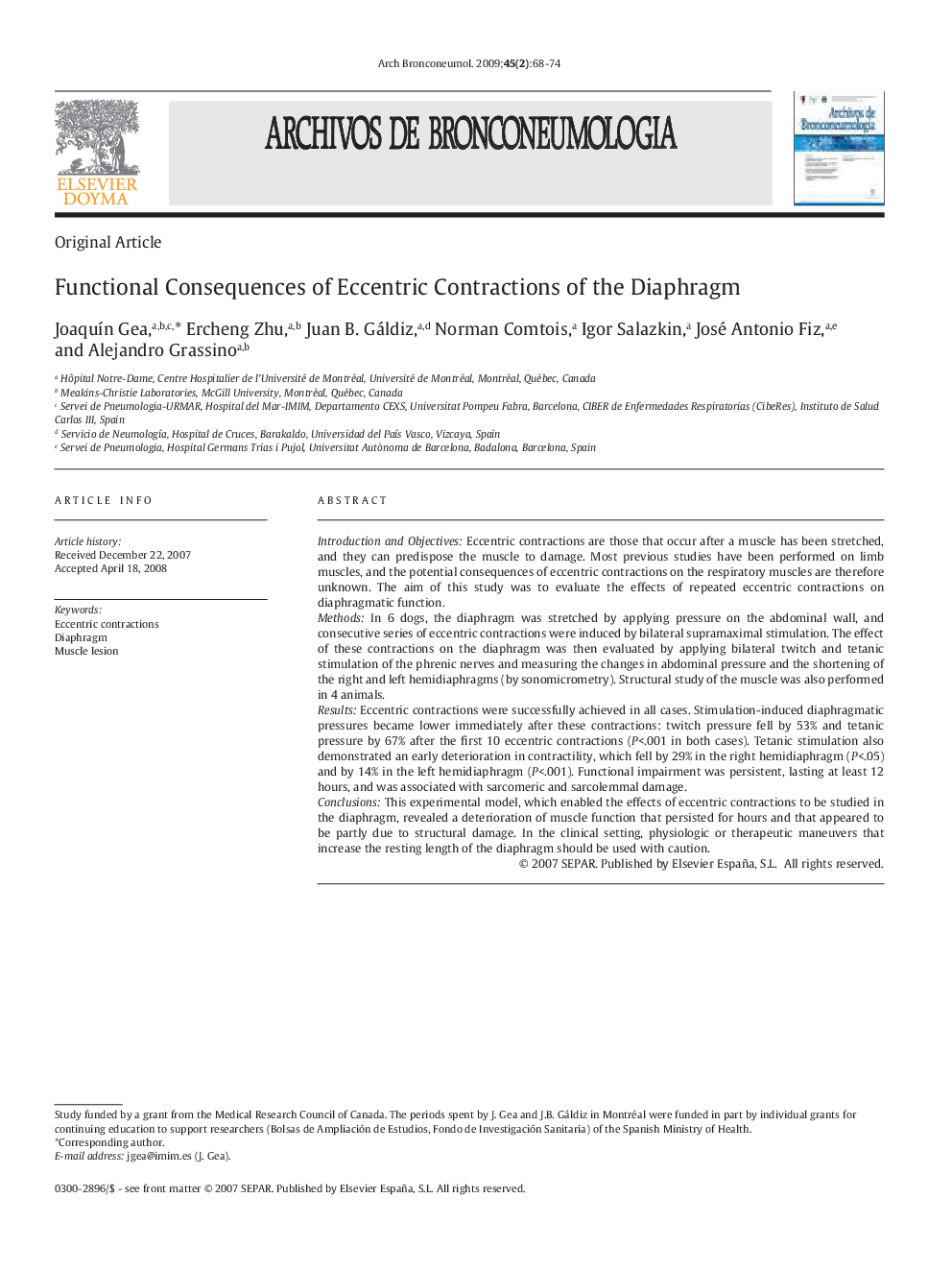| کد مقاله | کد نشریه | سال انتشار | مقاله انگلیسی | نسخه تمام متن |
|---|---|---|---|---|
| 4206802 | 1280017 | 2009 | 7 صفحه PDF | دانلود رایگان |

Introduction and ObjectivesEccentric contractions are those that occur after a muscle has been stretched, and they can predispose the muscle to damage. Most previous studies have been performed on limb muscles, and the potential consequences of eccentric contractions on the respiratory muscles are therefore unknown. The aim of this study was to evaluate the effects of repeated eccentric contractions on diaphragmatic function.MethodsIn 6 dogs, the diaphragm was stretched by applying pressure on the abdominal wall, and consecutive series of eccentric contractions were induced by bilateral supramaximal stimulation. The effect of these contractions on the diaphragm was then evaluated by applying bilateral twitch and tetanic stimulation of the phrenic nerves and measuring the changes in abdominal pressure and the shortening of the right and left hemidiaphragms (by sonomicrometry). Structural study of the muscle was also performed in 4 animals.ResultsEccentric contractions were successfully achieved in all cases. Stimulation-induced diaphragmatic pressures became lower immediately after these contractions: twitch pressure fell by 53% and tetanic pressure by 67% after the first 10 eccentric contractions (P<.001 in both cases). Tetanic stimulation also demonstrated an early deterioration in contractility, which fell by 29% in the right hemidiaphragm (P<.05) and by 14% in the left hemidiaphragm (P<.001). Functional impairment was persistent, lasting at least 12 hours, and was associated with sarcomeric and sarcolemmal damage.ConclusionsThis experimental model, which enabled the effects of eccentric contractions to be studied in the diaphragm, revealed a deterioration of muscle function that persisted for hours and that appeared to be partly due to structural damage. In the clinical setting, physiologic or therapeutic maneuvers that increase the resting length of the diaphragm should be used with caution.
ResumenIntroducción y objetivosLas contracciones excéntricas (CC.EE.) se caracterizan por producirse previa elongación muscular, lo que facilita la lesión. La mayoría de los estudios precedentes se han desarrollado en músculos de las extremidades, por lo que se desconoce la relevancia potencial de las CC.EE. en los músculos respiratorios. El objetivo del presente trabajo ha sido evaluar los efectos funcionales de series repetidas de CC.EE. sobre el diafragma.MétodoSe provocó la elongación del diafragma mediante presión externa abdominal en 6 perros y se indujeron CC.EE. mediante series consecutivas de pulsos supramáximos bilaterales. El efecto se valoró mediante la posterior respuesta del músculo ante estimulación frénica bilateral tanto de pulso único como tetánica, en términos de presión y acortamiento (sonomicrometría) de los hemidiafragmas derecho e izquierdo. En 4 casos se realizó estudio estructural.ResultadosSe consiguió inducir CC.EE. en todos los casos. Las presiones diafragmáticas inducidas por estimulación disminuyeron inmediatamente después de la actividad excéntrica (pulso único: 53%; tetánica: 67%; p < 0,001 en ambas, tras las primeras 10 CC.EE.), al igual que la propia contractilidad diafragmática (evidenciable con la estimulación tetánica; hemidiafragma derecho un HD 29%, p < 0,05, e hemidiafragma izquierdo, un 14%, p < 0,001). La disfunción fue persistente (duró al menos 12 h) y se asoció a la presencia de daño sarcomérico y sarcolémico.ConclusiónCon el modelo propuesto, que permite estudiar el efecto de las CC.EE. en el diafragma, se demuestra una pérdida funcional mantenida durante horas, que en parte parece debida a una lesión estructural. Clínicamente se debería ser cauto con las maniobras fisiológicas o terapéuticas que impliquen la elongación basal del diafragma.
Journal: Archivos de Bronconeumología ((English Edition)) - Volume 45, Issue 2, February 2009, Pages 68-74